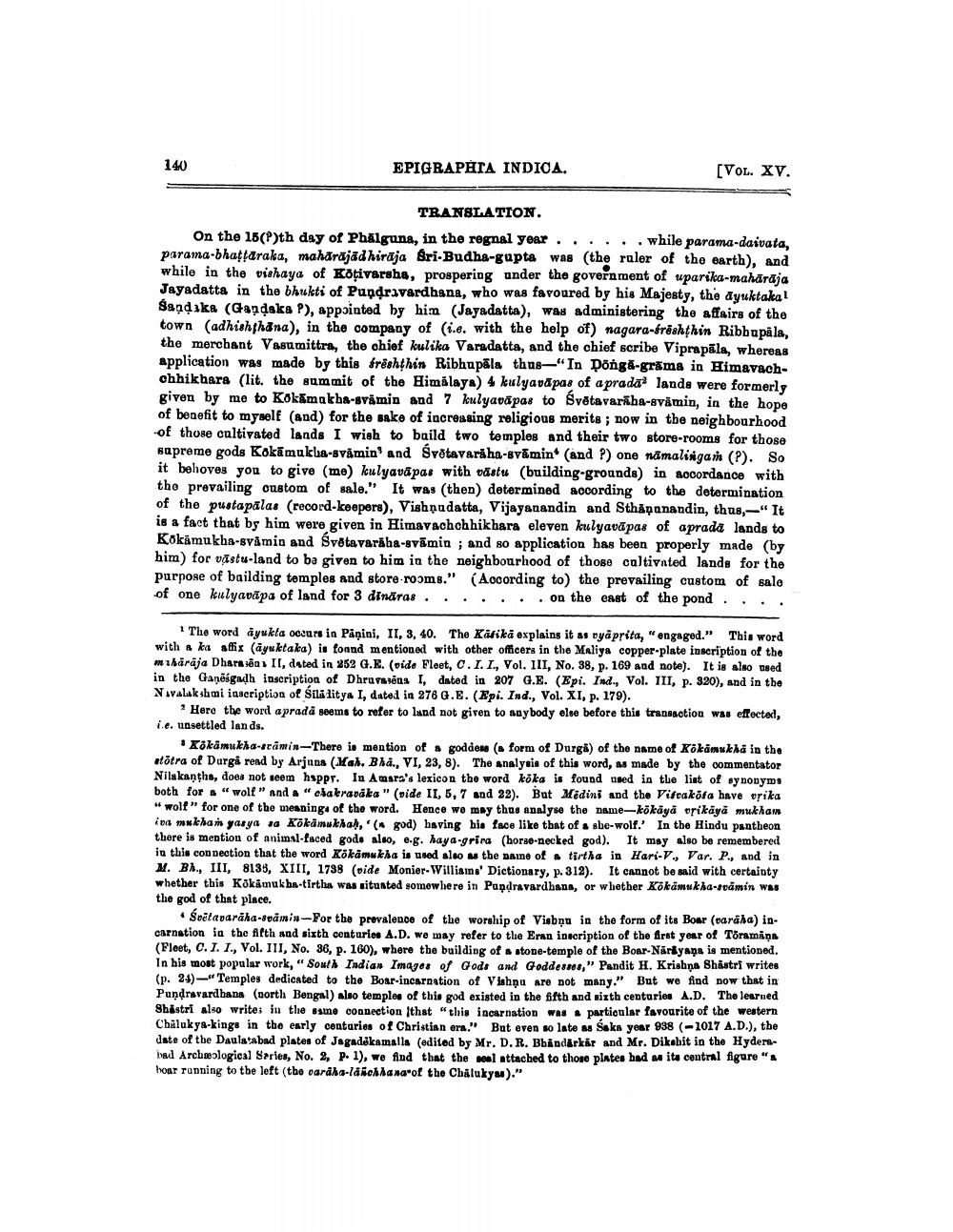________________
140
EPIGRAPHTA INDICA.
[VOL. XV.
TRANSLATION On the 15(P)th day of Phalguna, in the regnal year ...... while parama-daivata, parama-bhattdraka, maharajadhirāja Sri-Budha-gupta was the ruler of the earth), and while in the vishaya of Kotivarsha, prospering under the government of uparika-maharaja Jayadatta in the bhukti of Pundravardhana, who was favoured by his Majesty, the Ayuktakal Sandika (Gandaka P), appointed by him (Jayadatta), was administering the affairs of the town (adhishthana), in the company of (i.e. with the help of) nagara-brēshthin Ribbupala, the merchant Vasumittra, the chief kulika Varadatta, and the chief scribe Viprapāla, whereas Application was made by this freshthin Ribhupāls thus-"In Donga-grima in Himavachchhikbara (lit. the summit of the Himalaya) 4 kulyavapas of a prada lands were formerly given by me to Kokamakha-svämin and 7 kulyavāpas to Svētavaraha-svämin, in the hope of benefit to myself (and) for the sake of increasing religious merits ; now in the neighbourhood of those cultivated lands I wish to build two temples and their two store-rooms for those sapreme gods Kokāmukla-svåmin and Svētavaraha-svāmin (and ?) one namalingan (?). So it behoves you to give (me) kulyavā pas with Dastu (building.grounds) in accordance with the prevailing onstom of sale." It was (then) determined according to the determination of the pustapālas (record-keepers), Vishnudatta, Vijayanandin and Sthapanandin, thus," It is a fact that by him were given in Himavachchhikhara eleven kulyavāpas of aprada lands to Kokamukha-svimia and Svētavarába-svāmin ; and so application has been properly made by him) for vīstu-land to ba given to him in the neighbourhood of those cultivated lands for the purpose of bailding temples and store-rooms." (According to the prevailing custom of sale of one kulyavāpa of land for 3 dināras ....... on the east of the pond....
1 The word ayukta oosurs in Panini, II, 3, 40. The Käfika explains it as vyáprita, "engaged." This word with a ka affix (ayuktaka) is found mentioned with other officers in the Maliga copper-plate inscription of the mikäraja Dhara sēna II, dated in 252 G.E. (oide Fleet, C.I.L., Vol. III, No. 38, p. 169 and note). It is also used in the Gaņosgadh inscription of Dhruyssens , dated in 207 G.E. (Epi. Ind., Vol. III, p. 320), and in the N svalakshmi inscription of siladitya I, dated in 276 G.E. (Epi. Ind., Vol. XI, p. 179).
Hero the word a prada seems to refer to land not given to anybody else before this transaction was effected, i.e. unsettled lands.
Kökämukha-sramin-There is mention of goddess (a form of Durg) of the name of Kökamukha in the totra of Durgå read by Arjuna (Mal. Bha., VI, 23, 8). The analysis of this word, as made by the commentator Nilakanths, does not seem happr. In Amsra's lexicon the word koka is found used in the list of synonyms both for a "wolf” and a "obalravka" (vide II, 5, 7 and 32). But Médini and the Viftakófa have orika "wolf" for one of the meaning of the word. Hence we may thus analyse the name-kökaya orikaya mukham ina mukhan yasya sa Kokamukha), (* god) having his face like that of sbe-wolf.' In the Hindu pantheon there is mention of animal-faced godo also, e.g. haya-grira (horse-necked god). It may also be remembered in this connection that the word Kókamukha is used also us the name of tirtha in Hari-V, Var. P., and in M. B)., III, 8135, XIII, 1738 (vide Monier-Williams' Dictionary, p. 312). It cannot be said with certainty whether this Kokāmukha-tirtha was situated somewhere in Pandravardhana, or whether Kokamukha-sramin was the god of that place.
• Svitavaraha-spåmin-Por the prevalence of the worship of Visbņu in the form of its Boer (varaha) in. carnation in the fifth and sixth conturies A.D. we may refer to the Eran inscription of the Arst year of Toramina (Fleet, C. 1. I., Vol. III, No. 86, p. 160), where the building of stone-temple of the Boar.Nariyana is mentioned. In his most popular work, "Soul Indian Images of Gods and Goddesses," Pandit H. Krishna Bhastri writes (p. 24) - Temples dedicated to the Boar-incarnation of Vlahou are not many." But we find now that in Pandravardhana (north Bengal) also temples of this god existed in the fifth and sixth centuries A.D. The learned Shastri also write in the saine connection that "this incarnation was partioular favourite of the weatern Chalukya.kings in the early contaries of Christian era." But even so late as Saks year 938 (-1017 A.D.), the date of the Daulatabad plates of Jagadókamalla (odited by Mr. D.R. Bbandarker and Mr. Dikshit in the Hyderbad Archeological Series, No. 2, p. 1), we find that the real attached to those plates had wita central figure" hoar running to the left (the varaka-ldichiana of the Chilukym)."




